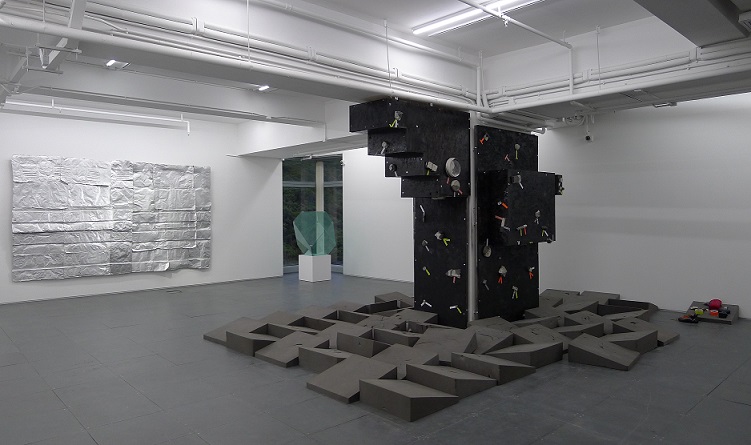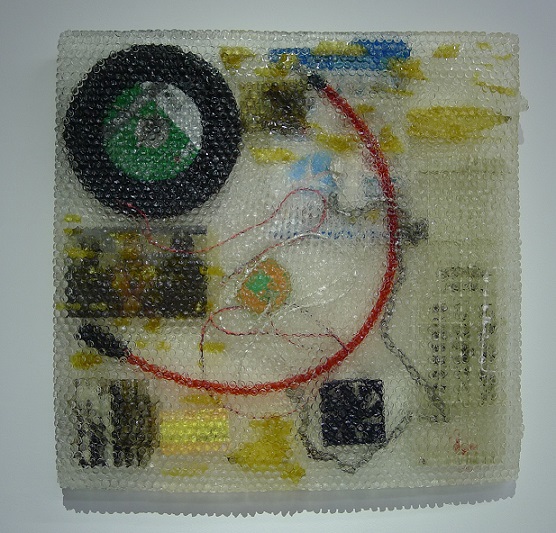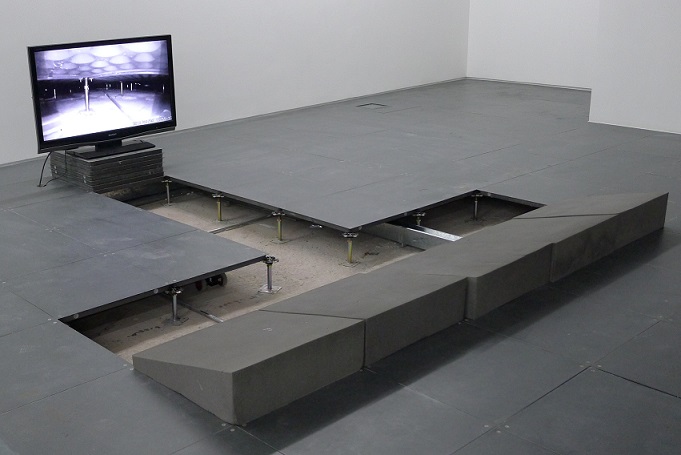藝評
Andrew Luk
約翰百德 (John BATTEN)
at 1:04pm on 21st November 2017





Captions:
1.-2. Andrew Luk, Black Square Problem (we're talking about practice), mixed media, 295x480x580cm, 2017 (2 images)
3.Andrew Luk, Catalyst Kit No. 3, mixed media, 58x58cm, 2017.
4.Andrew Luk, Escavator, single channel video and mixed media installation, 2017
5.Andrew Luk, Peep Holes (detail), four channel video, 60x60cm, 2017
All images photographed by John Batten
(原文以英文發表,評論陸浩明個展。)
Andrew Luk’s short exhibition, ‘Practice’, was the culmination of a month-long summer residency for the Hong Kong artist at de Sarthe Gallery. Given a large section of the gallery to use as a working studio, Luk collected a range of material to produce mixed-media installation pieces, some directly integrating with different physical parts of the gallery. The result was an exhibition whose rawness was embellished by the finished beauty of the wall-based art pieces (his Horizon Scan and Catalyst Kit series) alongside experimentations that successfully moved from studio-idea to resolved sculptural form.
The main installation Black Square Problem Setting (we’re talking about practice) references Russian artist Kazimir Malevich’s minimal Black Square (1915) painting, that radically for the time, deleted all content from the painting. Malevich explained: "I transformed myself in the zero of form and emerged from nothing to creation, that is, to Suprematism, the new realism in painting, to non-objective creation." I believe Luk’s own intention in this installation is to shift Malevich’s idea by literally putting the audience back into the picture by building a functional climbing wall around a gallery pillar, and when “…more climbers take to the structure, (using) the hand and foot holds…(it) gives the work an accurate sense of its actual form, addressing a dependence on people at large applying value and personal experience to art. Even if at times it seems to exist in a hermetic space”. In other words, even if art is obscure, or isolated from the real world (“hermetic”), or, as in Malevich’s minimal “black square”, it will have content if there is an audience present. Luk thus fulfills one of conceptual artist Marcel Duchamp’s key components for an art piece to be art: the necessity of having an audience to view the art.
Luk’s Peep Holes continues this idea of audience engagement; literally getting us on our knees to look closely through viewing peep holes drilled into the gallery floor. This voyeuristic action gives a glimpse of a subterranean world of people engrossed in their smart-phones and laptops. However, it is not the content on the monitors of the glimpsed electronic devices that is of interest, but the entire action of the audience: bending over, looking, and then, possibly, reflecting on what they have seen and, more significantly, done. It is the entire action that is the art. There is a similar intention in the intriguing video footage of Escavator; that shows a remote controlled vehicle with attached camera maneuvering beneath the gallery’s floor. This floor is not as solid as it looks; it is a façade, a false floor. The video could be an exploration of an excavated setting, such as in a cavern or tunnel, but it also suggests, as alluded to in the title, a followed escape route. The audience is privy to any possible scenario, but it is an unsettling feeling having such a rat-like view and knowing that our viewpoint is under control, albeit by the artist. Nevertheless, Luk successfully allows the audience a glimpse of this hidden place to channel multiple fictitious stories.
Luk employs familiar everyday objects and stretches their usefulness with carefree violence. Taking a cue from the techniques of producing a relief print, Compression Lifting is an impression of a nearby Wong Chuk Hang industrial building’s lift interior. The aluminium foil has been bashed, impressed and cajoled to become an elongated interior landscape. The result has a silvery lunar, other-worldly luminescence, far removed from the boxed claustrophobia of the original lift. There can be great beauty in such mundane everyday objects. Luk’s Catalyst Kit series is a jumble of arranged objects within a rectangle of set resin ‘held’ by an impression of bubble-wrap, if it were food it would be ‘in aspic’. These are beautiful finished pieces with a touch of intrigue: the minimal, but organized, combination of found objects beckons speculation to the artist’s and the artwork’s intention.
Luk completed two Distilled of Fire Leaves pieces using a plastic air-conditioner cover as the main component in each. The plastic covers are intentionally – and by the look of the controlled outcome, expertly – burnt. The result is a melted, surreal, contorted spider-web-ish physical form that is spot-lit to cast an eerie and effective shadow against the gallery wall and floor. Such a technique sits at the cusp of success and failure in production – there is trepidation, like a nervous ceramicist awaiting the opening of a kiln to reveal the results of a firing. Luk’s work is exactly that: experimentation, thoughtful and often daring, through practice.
This review was originally published in Artomity, Number 6, November 2017
